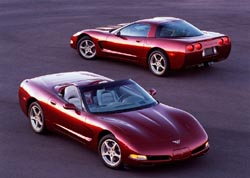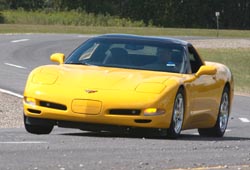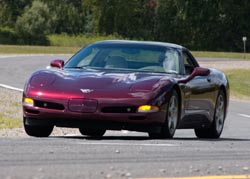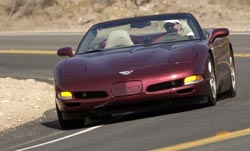|
 |
 by Hib Halverson
Page5 |
The Bad Dip, Inch-by-Inch
Enough of the deep-geek stuff. Let’s go back to the R/H Loop
at Milford and examine what Magnetic Selective Ride Control does when one
traverses the "Bad Dip" at 120 miles per hour.
First we need to know how much ground is covered in a given
time. At 120, you’re covering 176 feet every second. MR takes about 10-mSec to
respond and in that time the car only moves 21 inches. From here on, the best
guy to explain what happens is Mike Neal.
|

|
|
Mike Neal offers a blow-by-blow...oops...bad words...let’s say, a
millisecond-by-millisecond account of what MR does when the car crosses
the Bad Dip. Image: author. |
|
"In a basic sense, MR tries to maintain body movement in a
plane in space as the car moves forward. Calculations taking place in the
controller are always trying to achieve that end.
"When you enter the dip, the wheel position sensors, seeing
the wheels falling down into the dip, give a signal to the controller that a
large body event is taking place. The controller determines the next thing the
body will do is pitch down.
"Before the body can be pulled down, MR goes very soft on the
rebound damping, not only to let the wheels fall into the dip, but to let the
springs actually push the wheels into it. Without MR, you’d have heavier rebound
damping which would tug the front end into the dip. MR avoids that by turning
down the rebound. Again, sky hook is trying to keep the body in a flat plane.
|
"Once the tires near the bottom of the dip, the body wants to
fall into it, too, so MR gets very stiff on the compression damping. It takes
much longer for the body to move down on the suspension because compression
damping is, now, very stiff.
"When you start coming up, out of the dip; the controller
sees the suspension starting to be shoved up into the body. To keep the body
from pitching upwards, sky hook sets the shocks very soft on the compression
side, so the suspension will easily move up but not pitch the body up as you
come up, out of the dip on the other side."
Consider carefully what Neal just said: as the car starts out of
the dip, Magnetic Selective Ride Control switches through nearly its full range
of compression damping, from very stiff to very soft. It does this in around 10
milliseconds while the car, traveling at 120 mph, moves about two
feet...amazing!
"As you finally clear the dip,"
Neal continues,
"you might have some, secondary, cyclic motion taking place which pitches the
body. The controller sees that, sky-hook-calculates, then applies whatever
appropriate level of compression and rebound damping to properly damp those
motions."
"This is just what the body control strategy is across this
one bump. At the same time, the system may be doing wheel control and stability
enhancement, too. MR’s actions are never simple. It can be using several
different algorithms to control varied types of suspension movement
simultaneously."
Star Wars? Rocket science? You bet.
On the Road with MR
|
Blasting across dips at 120 is an extreme exhibition of
Magnetic Selective Ride Control’s abilities even borderline-crazy C5ers
shouldn’t try at home. So, what kind of driving will make you glad you ordered
MR on your 2003 Coupe or Convertible?
"If you’re on a smooth road,"
Mike Neal told us,
"while you’ll notice better isolation, it’s advantages
to handling are minimal. It’s on roads which cause large ride events and body
motion where it has huge benefits.
"If you’re trying to get around a track that’s smooth, like
Road America, a ‘billiard table’ having no great heaves and undulations, MR has
a minor effect.
|
|

|
|
Magnetic Selective Ride Control is standard on all 50th Anniversary cars
and optional on any 2003 Coupe or Convertible.
Image: Chevrolet Communications. |
|
"But, go to a place like the Nürburgring in Germany where
it’s like the asphalt was laid down after little or no grading or smoothing–lots
of dips and undulations–and you’re takin’ every turn at 100 mph or faster. It
doesn’t take much of a ride event to really unload the car by heaving it,
pitching it around and rolling it. In a place like that, MR is a huge advantage.
|

|
|
MR doesn’t offer the sporting driver that much
on a flat track, like this section of the Milford Proving Ground, other than a
little less body roll in transitions as MR dials-up the roll damping. Shown here
is Darin Dellinger at the wheel of a base 03 Coupe.
Image: author |
|
|

|
|
At about the same spot on the track we see Mike Neal in a 50th Coupe
with MR. Note less body roll. Image: author. |
|
"With MR, you don’t have to wait for the body to settle
before making your next steering input because the car is already transitioned,
ready for the next maneuver. In that kind of ride environment, MR greatly
improves the Corvette’s handling."
Nürburgring, huh.
Uh well...that ain’t in the Registry’s budget this month.
Nevertheless, to fully appreciate MR, I had to find something beyond structured
tests at a proving ground in Michigan.
Two thousand miles southwest, I found that on roads I know
well. North of downtown Los Angeles are the San Gabriel Mountains. About eight
miles into the San Gabriels on State Route 2, hang a left on L.A. County N3.
Stay on that for about 30 miles and you end-up at the desert town of Palmdale
but you’ll have been over some of the better high-speed touring west of
Nürburgring.
The ’03 I was driving, a loaded 50th Convertible with an
automatic, was the perfect choice to see how MR works in the real world. After
you go left on N3, there’s less traffic and the road gets rougher, not potholes
and broken pavement, but heaves and undulations of different depths, heights and
lengths. There’s a few Nürburgring-style, bumpy, 100 mph turns, too.
|

|
|
The author, at speed on County Road N3 in Southern California’s San
Gabriel Mountains. Star Wars meets the 50th Car in the real world.
Image: Gary Peterso |
|
It was easy to feel MR making a difference. Compared to a
base car, it was like night and day. Considering this was a performance sports
car, the ride was quite plush and the isolation quite good.
Even compared to the previous RTD system, MR has improved
wheel control over the higher frequency (10-15 Hz) ride movements because it can
bring more damping authority to bear and it can switch between damping levels
quicker. The system effectively damps the big heaves, pitches and rolls that
come from bumps and dips or low spots on the edge of the road. If dips at the
Grounds weren’t enough, 30 miles, hauling-ass over N3 sold me on MagneRide.
|
Does MR have short comings? Really high frequency (17-20 Hz
or better) stuff, such as little ripples on concrete highways or
washboard/chatter-bump surfaces are a slight problem. In a straight line, the
ride is a little harsh and, when ripples’ frequency approach that of the vehicle
structure, you can hear kind of a subdued rumble. At high speed and at high
lateral acceleration over chatter bumps, the car wants to skate sideways.
MR seems to be less effective in damping this kind of
harshness presumably because, even with a 10mSec response, with the car moving
fast, it can’t react quick enough to bring the most ideal damping to bear. While
this harshness is a shortcoming, the types of surfaces that cause it are fairly
rare.
In fact, this might not be entirely an MR issue. The stiff
sidewalls of C5s run-flat tires amplify this type of harshness to the
suspension. Rumor has it that C6 will have a new, Goodyear EMT with vastly
improved harshness qualities and that might solve this problem.
On relatively smooth roads near the car’s limits in abrupt
transitions and turns at high lateral acceleration, a MR car’s base springs and
stabilizer bars show their inadequate roll stiffness. Sources tell us that DIY
tuners can trade a little isolation to make up some of this roll stiffness
deficit by adding Z51 stabilizer bars to MR cars. A C5 in the hands of a
talented, aggressive driver will react well to that change.
Hard core racers, autocrossers and very aggressive street
drivers will still want either Z51s or Z06es, both of which have higher rate
"stab" bars along with stiffer springs and fixed-valve shocks tuned specifically
for motorsports.
After all this discussion of MagneRide, I keep coming back to
this one, overriding and persuasive thought: It’s pretty damn amazing to be able
to drive a C5 really hard into a high-speed sweeper on a rough road and not have
the car upset by bumps, dips or rises. Yeah, you might get ABS and even see a
little Active Handling, but the big thing that makes the car more predictable
and handle so well when going really fast over rough stuff is MR.
Clearly, we are not the only ones who think this. Just before
the C5 Registry magazine deadline for the print version this article,
Popular Science magazine announced Magnetic Selective Ride Control as the
winner of its prestigious "Best of What's New" award in the Automotive
Technology category for 2002. This award recognizes products or technologies
that are a significant step forward in the category.
About a month before we posted the longer, Internet version
of this story on the C5 Registry web site, the December 2002 issue of the
Society of Automotive Engineers magazine, Automotive Engineering
International, named MagneRide one of its "Top 10 Technologies" for 2002.
Award-winning Magnetic Selective Ride Control–yeah, a bit
Star Wars it is, but it sure works well.
.
|
Return to
Article Beginning |
|
C5 Registry Magazine, the C5 Registry web site and the author would like
to thank Team Corvette’s Mike Neal and Dave Caldwell, Delphi’s Darin
Dellinger and Beth Lewis and Lord Corporation’s Dr. Lynn Yanyo for special
assistance in preparing this article |
Sponsored by:
 |
|
|